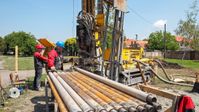
Geothermal energy is one of the fastest rising alternative energy options. According to the Environmental Protection Agency, geothermal systems are the most energy-efficient, environmentally clean, and inexpensive way to heat and cool buildings. Many people haven’t heard of this energy option, so they don’t know how they work or what components they contain. Below you will find a brief description of the elements of a geothermal option and how they work.
3 Parts That Make a Geothermal Energy System Work
1. Ground Loop
The ground loop is a system of small, high-density polyethylene pipes that are buried shallowly near the building you’re trying to heat or cool. This series of tubes is long, so contractors sometimes install it in a slinky-like configuration that keeps it compact. Next, they will pump a heat transfer fluid such as water or antifreeze through the pipes. The liquid removes heat from the earth surrounding the ground while it’s in heating mode or delivers heat to the ground in cooling mode. These pipes carry the heated fluid to the heat pump unit.
Ground loops come in two types: closed-loop or open-loop. If you have a closed-loop system, all of the fluid that goes through the building will be delivered back after it finishes its loop. In an open-loop system, a pump pulls water from a well and discharges it back into the same body of water, recycling it. Your contractor will recommend the best configuration for your home.
2. Heat Pump
 The heat pump furnace unit goes inside your home. It removes the heat from the fluid in the pipe, and then increases its consistency, concentrates it, and distributes it throughout the building. It provides both heating and cooling, depending on the system you choose. Contractors classify it’s size per ton and will help you pick the correct size and style.
The heat pump furnace unit goes inside your home. It removes the heat from the fluid in the pipe, and then increases its consistency, concentrates it, and distributes it throughout the building. It provides both heating and cooling, depending on the system you choose. Contractors classify it’s size per ton and will help you pick the correct size and style.
3. Air Delivery System
The air delivery system distributes the hot or cold air around your house. It either uses conventional ductwork or pipe systems. In a forced-air system, a fan blows the air through the ductwork. In a hydronic system, hot water goes through pipes that bring the heat up through a radiator or in-floor pipes.
Cowboy’s Heating & Air specializes in installing and maintaining geothermal systems in Dayton and Cincinnati, OH, as well as Northern Kentucky. Their quality HVAC technicians are experts in local soil types and geological conditions so that they can find the best system for your home. Visit their website to learn more about geothermal energy or call (937) 604-1541 to get a free quote.
About the Business
Have a question? Ask the experts!
Send your question

